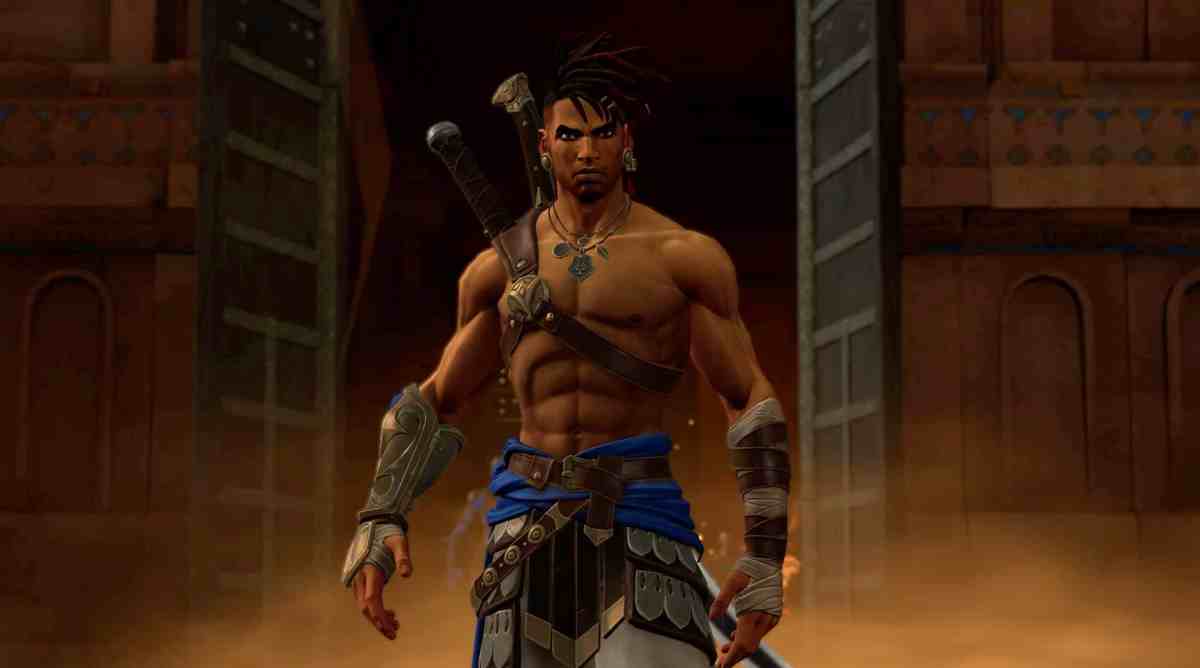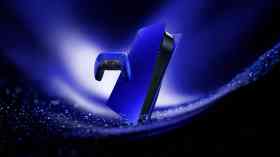There is beauty in every facet of Prince of Persia: The Lost Crown, the latest iteration of the long-running franchise; a game that returns to its roots with clever modern flair and a sleek approach to gameplay that emphasises snappy movement and graceful acrobatics, as well as careful timing and patience.
Those familiar with the action-adventure styling of modern Prince of Persia games will find this soft-reboot has a different flavour to its predecessors, but it retains a distinct sense of familiarity in its approach to combat, and the intricate mythology at its heart. The game was first revealed at the 2023 Xbox Game Showcase, and a deeper look was shared during the 2023 Ubisoft Forward.
As in past games, you play The Lost Crown as the titular Prince – this time, Sargon, a young and handsome member of The Immortals, a heroic group who protect the kingdom of ancient Persia with a range of special abilities. Sargon, like his brethren, is super strong, lithe, and agile. He also wields twin swords and a crossbow with a ease, and he can deploy a range of special abilities – time-stopping teleportation, a healing circle, and a slashing frenzy that obliterates opponents.
Read: Summer Game Fest 2023 – All the game trailers and announcements
In a 30-minute gameplay preview shown to GamesHub during a Ubisoft media event, Sargon came off as impressive. Young but fierce, relatable as a younger and occasionally exasperated sibling, and determined in his quest to rid Persia of evil.
As described by Ubisoft, the game’s plot revolves around the abduction of a noble Queen’s son, which takes place amidst a portal-infused time crisis. While Persia is usually peaceful, The Lost Crown sees the land besieged by strange anomalies that twist and warp the landscape, creating great cracks and and oddities in the sky and on land.
From within these cracks, monstrous beings emerge – fabled creatures from mythology, skeleton warriors from eras past, and a cavalcade of other fiends destined to face Sargon’s lethal combination of weaponry.
A new generation of Prince
There is a distinct grace to Sargon’s, as he jumps, fires off arrows and spins — sword-dancer-style — towards enemies. Attack combinations string together with a simple button presses, making each battle a beautiful way for enemies to die. Per Jean-Christophe Alessandri, Art Director at Ubisoft Montpellier, this was a core focus for the the game’s development team, who aimed to elevate the game’s style to match Sargon’s unique abilities and finesse.
‘You’ve seen the character is a gifted young warrior, and he has super abilities, and he’s fast, and he must be agile.’ Alessandri told GamesHub. ‘[We decided] these key points should be [part] of the design of a character who doesn’t need a strong armour style – so he has very light armour. He’s super powerful, but at the same time, he has weaknesses. He takes risks.’
‘He has no clothes, no protection, but this way, he can be fast. Being light in movement – acrobatic – this is the main idea of the character.’

Sargon was also born of a desire to modernise the image of Prince of Persia, with a new hero who is attractive not only on the surface, but in his moveset and style. ‘We wanted to bring some fresh visual design and taking inspiration from, for example, modern references, modern culture, urban culture, and fashion. It’s a new way for us to bring this fresh vision of the character.’
Minting a new legend
To capture the weightlessness and gravity-defying movement of Sargon, Ubisoft Montpellier moved away from traditional motion capture when designing the Prince. While motion capture was used for cutscenes, to more realistically depict Sargon and The Immortals, the team chose to focus on stylish and snappy, ground-up animation for combat and exploration.
‘All the gameplay animations are made by keyframe animation. It was a really important part for the final quality of the animation – so we have some very strong animators specialising in keyframe. In this way, we could create … this feeling of power.’
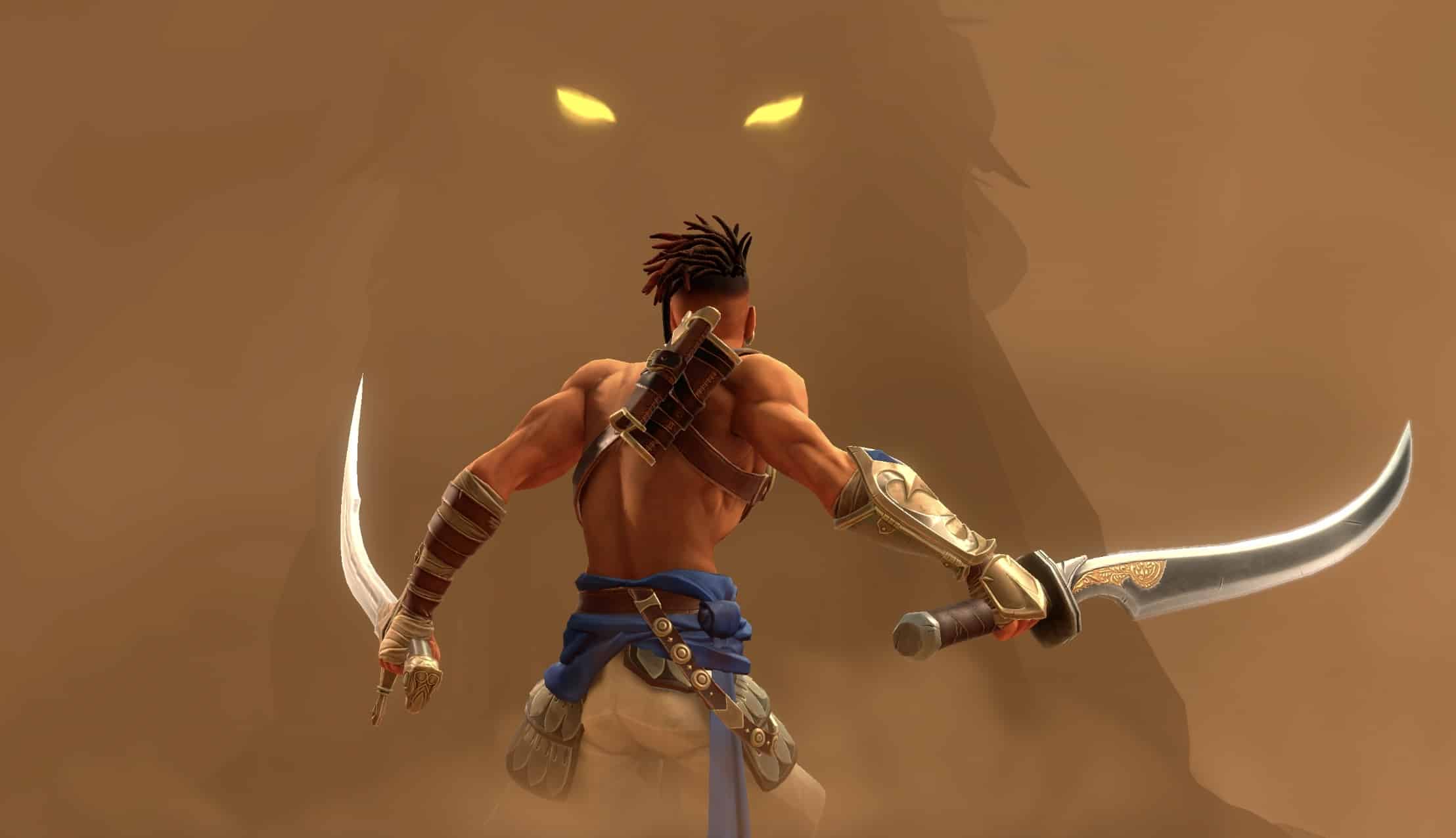
In our preview with the game, this sense of style, power, and creativity was firmly on show, not only in the game’s flashy and good-looking combat, but in its side-scrolling traversal system, too – and in the greater world of Persia which Sargon calls home.
The first chapter of the game begins in Mount Qaf, a legend of Middle Eastern mythology said to be home to the mysterious jinn. Prince of Persia: The Lost Crown leans into this mythological tie heavily, with the game’s action infused by magic throughout its opening.
‘The goal was not being strictly accurate,’ Alessandri explained, ‘but in keeping the essence of the scripture, and being very respectful. At the same time, bring our own vision, bring that into a fantasy world. It’s an interpretation, [with] the essence of the passion and richness of Persian mythology.’
Realms we traversed were littered with magical doors, and in one sequence, we stumbled across an entire platforming level hidden within a special void, activated by force.
Upon hitting this void, a Sphnix-esque statue manifested, encouraging wall climbing and challenging leaps across great obstacles to reach new heights, take on new enemies, and gather more crystals (which can unlock new weapons, health items, and other collectibles.)
In another sequence, great mushroom-like platforms burst through the stonework of towering buildings, with each forming a leaping pad across great ravines, some littered by spiked obstacles and swinging meat grinders – in sequences that strangely brought to mind the excellent Super Meat Boy.
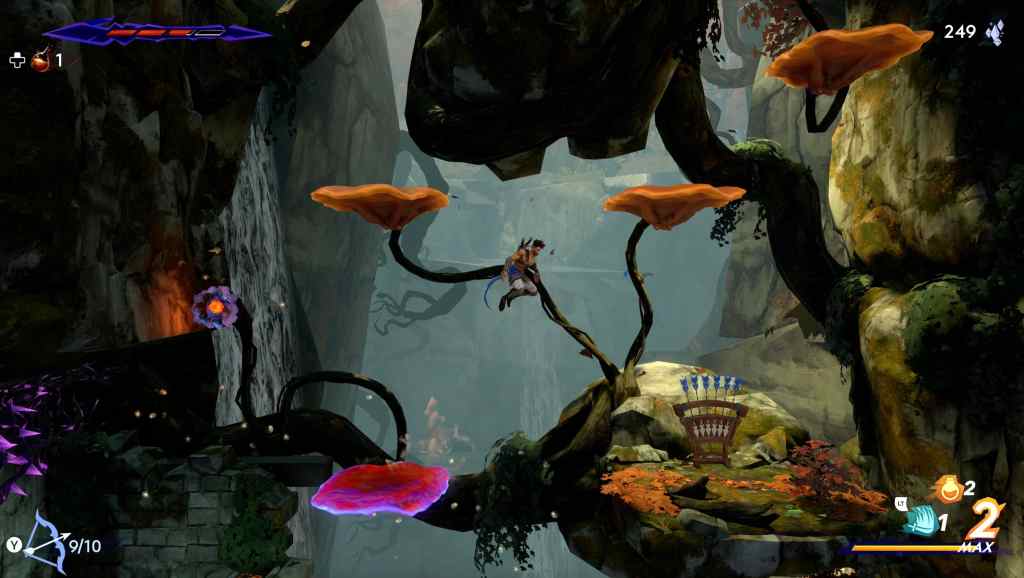
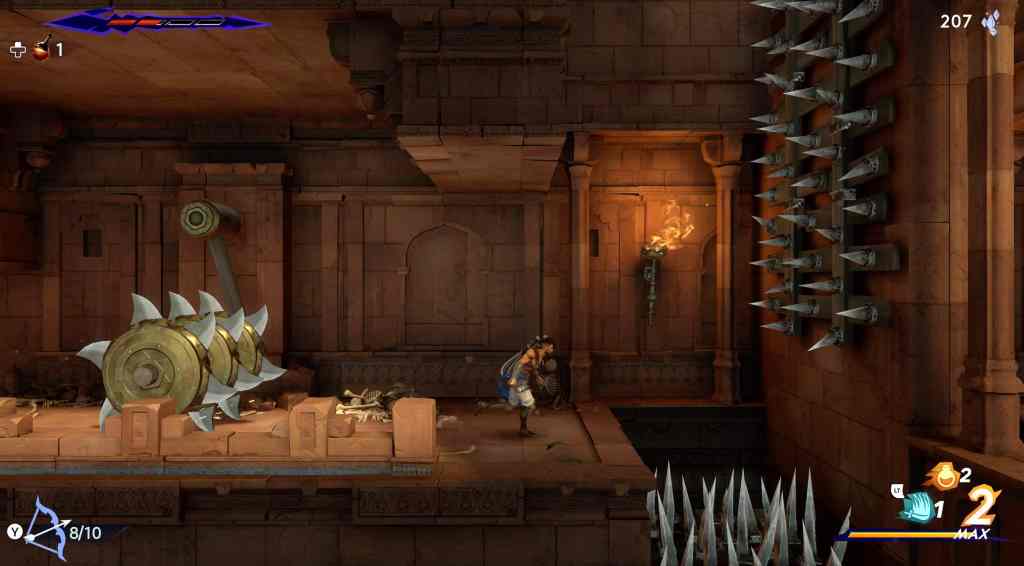
In these sequences, Prince of Persia: The Lost Crown shone brightest, as the flow is infectious. You can dart across a corridor, take out the knees of a skeleton guard, then leap up a thin chasm, dodging spikes and near-death, before spotting an awaiting razor pillar, and dodging at exactly the right time to survive. It makes you feel clever; chuffed on greatness.
Then, a towering boss will appear to cut you down a few levels.
The great beast Jahandar
The final obstacle in the early preview for Prince of Persia: The Lost Crown was a towering boss – the mythological Jahandar, something of an ogre-eagle-scorpion-lion-dragon chimera. In his battle sequence, the game opens up massively; Sargon is incredibly small compared to Jahandar, and the arena nearly engulfs him. It’s an effective tool to emphasise the danger of this boss, and the dramatic, frantic dance of combat you’ll need to overcome him.
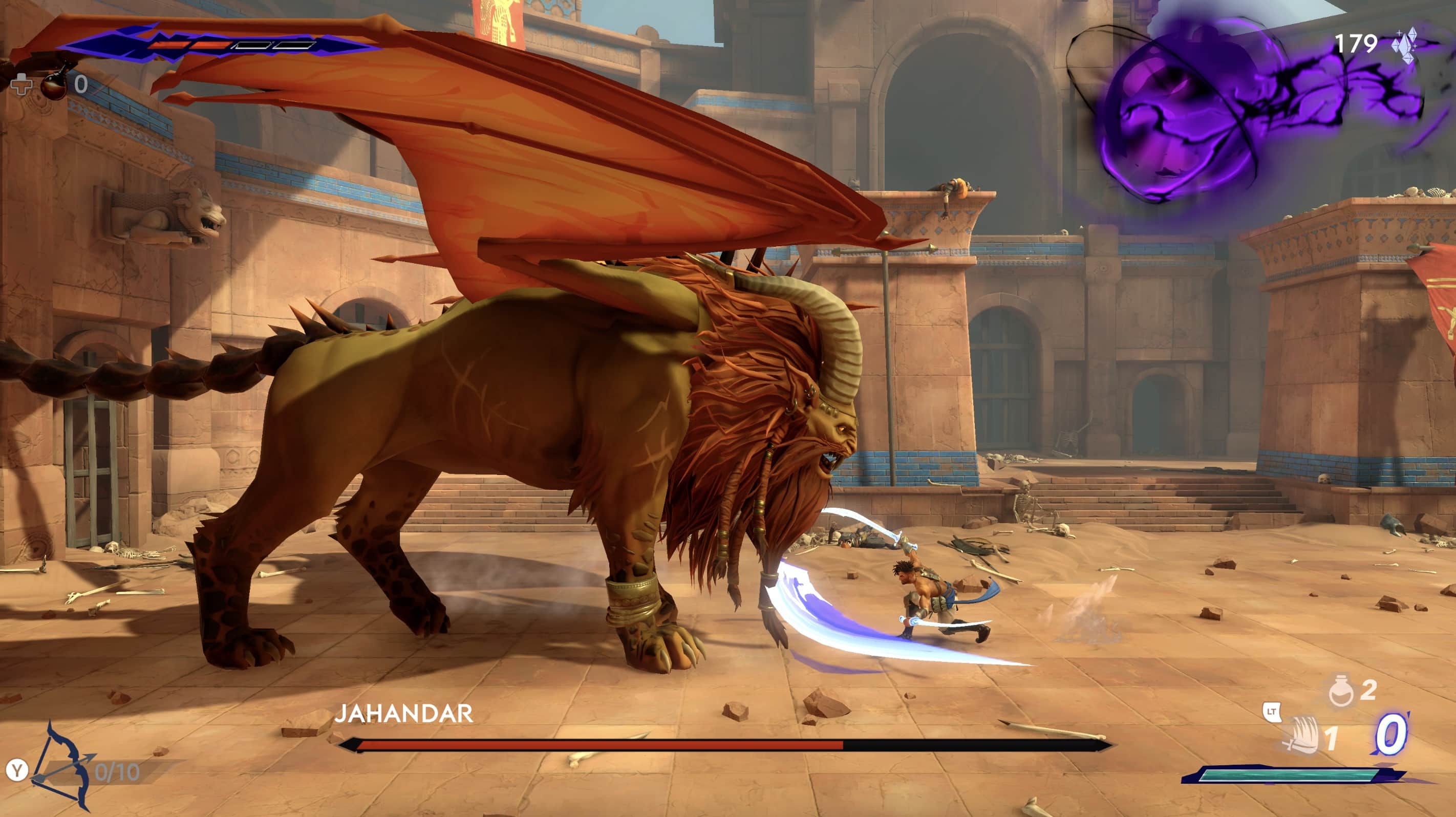
It’s best described as a dance, as it’s a complicated whirl of buttons and animation analysis that’s required to deck Jahandar. You need to watch for his scorpion tail as it bites into the earth or sweeps in a great arc, watch his head as he leans down to charge (countered with a perfectly-timed parry), and then monitor your situation from multiple sides as he unleashes a glowing purple orb that strikes deadly lightning at the most inconvenient of times.
The fight is extremely difficult, and requires that aforementioned patience. It is worth noting, however, that it can be overcome – as The Lost Crown is a generous teacher. Spend enough time analysing Jahandar’s movements, and you’ll see the flaws in his defences light up. You’ll learn to time your parries, when to heal, and when to jump, dodge, or teleport.
While frustrating in a preview situation – with the game’s lovely developers watching closely and providing well-meaning advice on every death – this was briefly frustrating. But in taking the time to learn movements and think deeply about the full suite of Sargon’s abilities, the answers soon became clear, one death at a time.
Style and substance
Reflecting on the full scope of the Prince of Persia: The Lost Crown preview, the experience was mightily impressive – particularly given the titular Prince has been away for some time. Bringing back an older, beloved franchise is always a risk. These tales are rose-coloured by nostalgia, and some players will have a deep sense of longing for a definitive return to days of old, rather than a desire to experience something innovative or new.
But it’s in trying something new – arguably, something that’s also old, given the roots of Prince of Persia – Ubisoft Montpellier has formed a compelling new take on one of its oldest franchises, injecting it with a fresh sense of style and intrigue.
The Lost Crown has the potential to reinvigorate a franchise that has struggled, in the past, to recapture the imaginations of a passionate audience with high expectations. Give it time, and this adventure could blossom into something bold, and altogether beautiful.
Prince of Persia: The Lost Crown is set to launch for PlayStation 4, PlayStation 5, Xbox One, Xbox Series X/S, Windows PC, and
GamesHub travelled to Los Angeles, United States as a guest of Ubisoft to attend preview showcases and hold interviews with Ubisoft developers.
